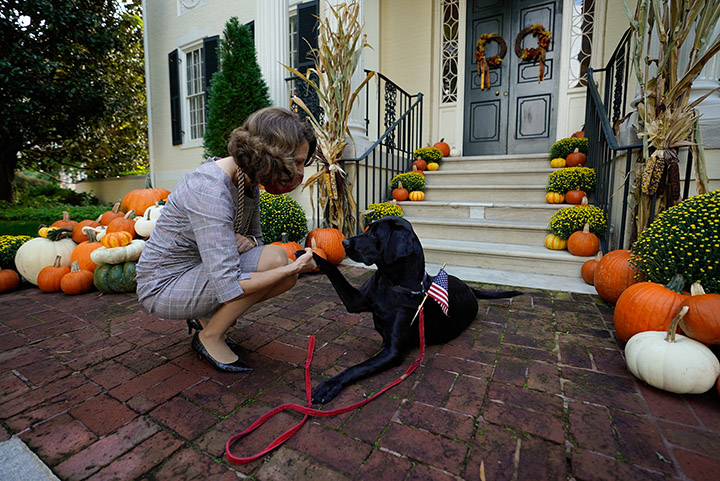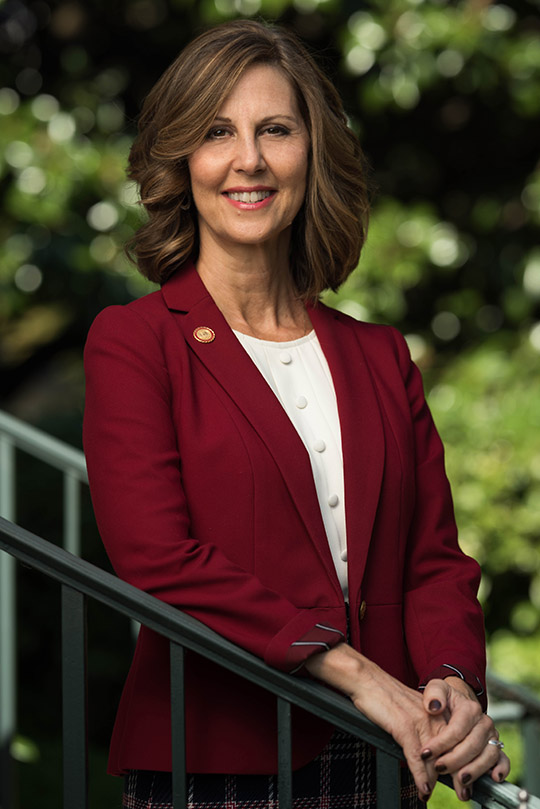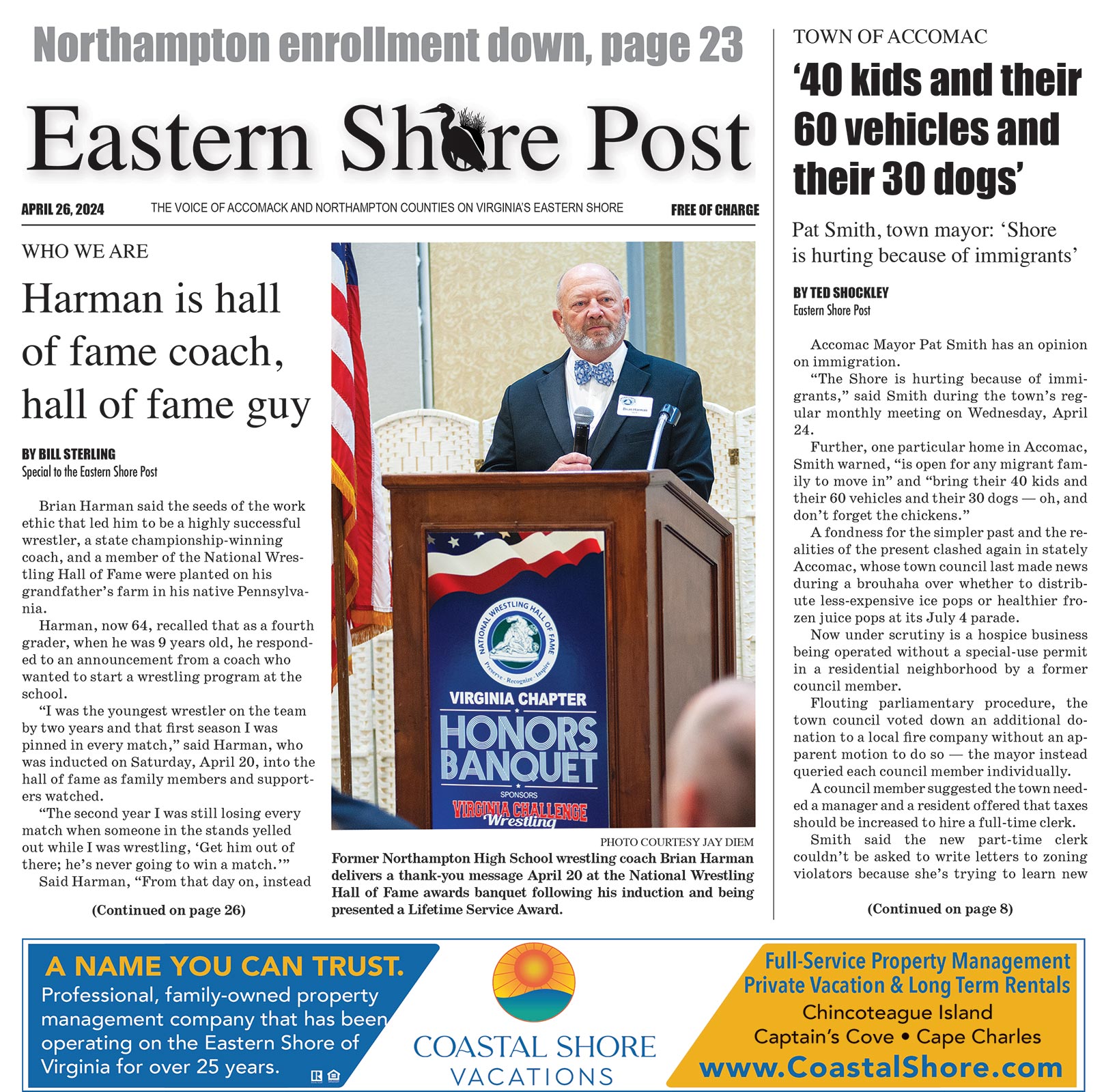By Martha Wessells Steger
Special to the Eastern Shore Post
Virginia’s first lady Pamela Northam echoed the sentiments of many visitors returning to the Eastern Shore when she said in a recent interview, “Once you cross the Chesapeake Bay Bridge-Tunnel, your worries just drop away into that salt air.” She and her husband, Gov. Ralph Northam, a Shore native, take every opportunity to be active — boating, walking, running, biking, and fishing, a hobby of the governor.
They also enjoy showing off the Shore at every opportunity. The latest occasion for that arose with the first full staff retreat, in October, for members of the executive mansion staff and the governor’s Cabinet at Kiptopeke State Park. On family visits, they’re often accompanied by their Labrador retriever — Murphy of Chincoteague — given to them by the governor’s brother, who practices law on the Shore, and father, who lives near Onancock. Now, there’s also Virginia Pearl, the new Northam Labrador puppy.

Not everything is as carefree for the first lady as a trip to the Shore. Life for her and the governor — like so many people in the state — became very different when they tested positive for COVID-19 Sept. 24. They experienced a mild-to-moderate case of COVID-19 and worked from home while in quarantine for two weeks.
Increased Funding for Child Care
One of their objectives in child care for the commonwealth came to fruition Oct. 21 with their joint announcement of $65.8 million in new funding — supported by federal Coronavirus Aid, Relief, and Economic Security (CARES Act) dollars — to increase access to child care and support child care providers amid the ongoing pandemic. This brings the total amount of CARES Act funding Governor Northam has dedicated to early learning and child care programs in 2020 to $138 million. This funding has helped about 2,000 of Virginia’s child care providers to remain open during the pandemic. The first lady is in touch with legislators about restoring some of the funding put on hold by the economic downturn associated with COVID-19.
Nearly 45% – approximately 2,600 – of child care programs closed their doors at the beginning of the pandemic. Thanks to more than $70 million in grants and other relief, many have reopened or are starting to, though thousands of children across Virginia remain on waitlists for child care. Pamela Northam made the announcement during a virtual meeting of the Children’s Cabinet, an advisory body to the governor, which she heads.
The Children’s Cabinet focuses on three major areas of school readiness: unifying the state’s early childhood education programs, creating a uniform rating system for early childhood education programs, and setting a long-term vision for the programs, with clear deadlines to ensure progress. “We’re also focused,” she said, “on the training and compensation of early educators. Teachers are key to improving school readiness.”
Funding announced in April – amounting to “less than an extra dollar-per-hour for child care providers,” she explained, “continues the incentive grant program for child care providers through the end of this year. It helps us show appreciation to private providers by moving them to pay parity with those who are publicly funded so they don’t have to get an extra job.”
Early Childhood Education Initiative
The first lady’s chosen initiative since her husband became governor Jan. 13, 2018, has been to improve the access to — and the quality of — early childhood education throughout the state. After moving into the executive mansion, she said she “spent a year researching early childhood educational systems and sought out experts on the subject.” She traveled more than 6,000 miles visiting what are referred to as “early childhood care and education providers” — elementary schools, child care centers, family day-homes, local departments of social services, and nonprofits.
“The goal on those trips,” she explained, “was to have conversations where we heard what early educators, parents, and local leaders needed from the state. This shaped the work we have done at the state level.”
A major focus has been working to ensure Virginia’s kindergartners are ready for school and that the state’s children have access to fresh and healthy food, something that nearly half a million Virginia children currently do not have. In addition to heading the Children’s Cabinet, she helped to bring about the state’s first chief school readiness officer, whose division works with other state agencies serving young children from birth to 5 years in the early childhood care and education system.
In developing her school-readiness initiative, Northam gained early support from leaders of the Virginia Chamber of Commerce, the Virginia Business Council, and the Virginia Early Childhood Foundation. As a partner in a political power couple, she also made a point to meet with Republicans as well as Democrats during the 2018 General Assembly to discuss her focus and solicit ideas from legislators. “It’s better to have a lot of voices at the table, but in the end, we need to speak with one voice,” she said.
One of those voices on the other side of the legislative table was that of Virginia House of Delegates Republican member Chris Jones, of Suffolk (who lost re-election in November 2019 after his 76th district was redrawn). “I met with the first lady and was pleased this was a passion for her,” he said. “Republicans had this on our radar for some time. We’re positioned to move ahead in getting the best bang for our buck in the delivery of early education in the commonwealth.”
Concern for Rural Areas
The circumstances of children living in rural parts of the state – often on very limited incomes – have been of special concern to her. Like her Eastern Shore husband, she grew up in a rural area – in Texas – and met Ralph Northam when he was a resident in pediatric neurology. After studying at Baylor University and the University of Texas, she specialized in pediatric occupational therapy, where her work included rehabilitation hospitals, teaching hospitals, and special education. She’s traveled on Richmond school buses with volunteer teachers, administrators, and cafeteria workers to deliver food to children out of school because of the pandemic.
The reasons for her initiative are not only personal – “We all want to love and care for our children,” she said — but imperative for the future of the commonwealth. “Early childhood education is the best investment we can make in our future workforce,” she explained. “Today’s kindergarten students will be putting the final bolts in the ships being planned now at Newport News Shipbuilding. We’re growing the workforce of the future.”
Northam gives inspirational credit for her early-childhood initiative to -immediate past first lady Dorothy McAuliffe, who mounted a campaign to feed thousands of hungry Virginia children daily. Northam has also been quick to give a nod to “local communities for leading the way” to innovative approaches for improving early childhood education in communities stretching from Danville to the Eastern Shore.
As someone who has been active for years in Hampton Roads environmental organizations, she has also worked to incorporate more environmental education into the broad field of education. Jay Ford, the Chesapeake Bay Foundation’s Virginia policy grassroots adviser based in Belle Haven, said, “For the first time in almost a decade, funding for environmental education in Virginia has doubled, and a lot of that is due to Pam’s quiet work behind the scenes. There are kids on the Shore who can throw a rock in any direction and have it land in a creek but have never been out on the water. We want to see that change with the additional funding.”
Looking Back, Moving Forward
Despite the challenge of moving from the private life of a doctor’s family into a public life that’s always in the spotlight, Northam has welcomed all of the surprises and opportunities – epitomized by living in the 1813 residence, the oldest governor’s mansion in the country still used for its original purpose. “We’re trying to tell a fuller story of this 207-year-old mansion,” Northam said. “Its history has had quite a trajectory: a civil war, two world wars, pandemics [including the 1918-1920 Spanish flu]. Along the way a lot of different people have cared for this home.”
The stories range from those of former first ladies to those of enslaved people. She praised the assistant director of the mansion, Kendall Battle, who is African American, for assisting with this effort and helping to plan a recent dinner for descendants of enslaved people who worked at the mansion.
The first lady came under fire a year ago for handing out raw cotton — growing behind the formal Charles Gillette garden at the mansion — to a group of Black Richmond students on a tour and asking them if they could imagine what it must have been like to pick the plant with its scratchy, coarse fibers. The incident occurred at the same period as the governor was apologizing for a photograph of him in blackface in a college yearbook. The first couple acknowledged a lack of sensitivity.
“No matter how much empathy we have, we can’t have the experiences that other people have had,” the first lady said in an interview for this article. “We all need each other to help us understand the complete experience.”
The former slave quarters and original kitchen overlooking the gardens — including a kitchen garden on the slope behind the formal garden — are important parts of “the complete experience” at the mansion. Northam and mansion staff have involved an inner-city garden group, Tricycle Gardens, in planting and composting native Virginia plants in the pollinator gardens. “We, of course, do everything naturally; no herbicides or pesticides,” she said.
The spaces inside the slave quarters are being pared down to educational use to tell — online as well as in person — the fuller story of the lives of enslaved peoples and first ladies. The preservation of the historic kitchen is part of the curriculum for educators.
The mansion’s interior has had two recent additions -— a painting Ethan Brown did of his Pamunkey ancestor, Chief Walter Bradby, which hangs in the ballroom; and a print of “Head of a Young Woman Veiled, 2019,” delivered to the mansion by artist Kehinde Wiley to hang there until it moves to a permanent gallery next year at the Virginia Museum of Fine Arts, which had purchased it.
Inside and outside, the Virginia executive mansion’s story becomes more robust. “We can’t move forward unless we know where we’ve been,” the first lady said.
She and her husband “will definitely be back in the 757-area-code again in the future,” she said in response to a question about the end of the governor’s term in January 2022 and a return to private life in Norfolk. “In the meantime, we’re still very focused on our littlest learners.”
The Northams have two grown children: Wes, a neurosurgery resident, and Aubrey, a web developer.



